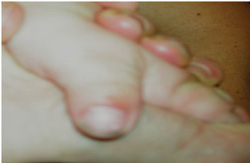Síndrome de Pfeiffer
también conocido como: Acrocefalosindactilia tipo Pfeiffer
¿Qué es el síndrome de Pfeiffer?
El síndrome de Pfeiffer es un trastorno genético caracterizado por la fusión temprana de los huesos del cráneo (craneosinostosis). Esto, a su vez, provoca anomalías en la cabeza y el rostro. La enfermedad está presente al nacer, y los síntomas pueden persistir y empeorar a medida que la persona crece. La incidencia anual del síndrome de Pfeiffer es de alrededor de uno en cada 100,000 nacimientos.
El síndrome de Pfeiffer fue descrito por primera vez en 1964 por el Dr. Rudolph Arthur Pfeiffer. Esta afección también se denomina acrocefalosindactilia tipo Pfeiffer, que significa cabeza “alta” con fusión variable de los dedos de las manos.
¿Cuáles son los signos/síntomas del síndrome de Pfeiffer?
El síndrome de Pfeiffer se ha dividido en tres categorías clínicas en función de las características clínicas encontradas en la persona afectada:
Tipo 1
- Craneosinostosis (cierre prematuro de las suturas del cráneo)
- Pulgares anchos y dedos de los pies grandes con fusión variable de hueso/piel de los dedos de las manos (sindactilia)
- Inteligencia normal/casi normal
Tipo 2
- Cráneo con forma de hoja de trébol debido a craneosinostosis de múltiples suturas.
- Proptosis ocular grave (ojos saltones)
- Pulgares anchos y dedos de los pies grandes
- Anomalías del sistema nervioso central
- Extensión limitada del codo
Tipo 3
- Similar al tipo 2 sin cráneo con forma de hoja de trébol

¿Qué causa el síndrome de Pfeiffer?
Esta afección es causada por un cambio (“mutación”) en un gen que forma parte de un grupo de genes denominados FGFR (genes del receptor del factor de crecimiento de fibroblastos). Se han encontrado mutaciones en dos genes FGFR en personas con síndrome de Pfeiffer. Los dos genes son FGFR1 y FGFR2.
Las mutaciones en el FGFR1 generalmente se encuentran en los casos más leves (tipo 1), mientras que las mutaciones en el FGFR2 se encuentran en personas con tipos 2 y 3. El síndrome de Pfeiffer se hereda en un patrón de herencia autosómica dominante. Por lo tanto, si una persona tiene síndrome de Pfeiffer, su descendencia tendría un riesgo del 50 por ciento de tener también síndrome de Pfeiffer.
La mayoría de las personas con síndrome de Pfeiffer son los primeros casos en la familia. Esto significa que los padres del/la niño/a afectado no tienen síndrome de Pfeiffer. Si los padres de un/a niño/a no tienen síndrome de Pfeiffer, el riesgo para sus otros embarazos es bajo.
¿Cómo se trata el síndrome de Pfeiffer?
Alrededor de 4 meses después del nacimiento, los niños con síndrome de Pfeiffer pueden requerir una cirugía para aliviar la presión en el cráneo (craneosinostosis) o la acumulación de líquido (hidrocefalia). Luego se inserta una derivación para continuar drenando el líquido del cerebro. Otros tratamientos que pueden ocurrir durante el primer año de vida incluyen abrir el cráneo para permitir que el cerebro crezca y cirugía cosmética o reconstrucción quirúrgica.
A medida que el/la niño/a crece, es posible que se necesiten tratamientos de apoyo adicionales, incluidos procedimientos dentales, procedimientos oculares y dispositivos de asistencia auditiva, como audífonos.
¿Cuál es el pronóstico para los niños con síndrome de Pfeiffer?
Con atención médica agresiva, el pronóstico para la mayoría de los niños con esta afección es positivo. Se requieren múltiples cirugías y terapias continuas para estos niños, pero la mayoría asistirá a la escuela, tendrá amigos y, sobre todo, disfrutará de la vida. Con un seguimiento minucioso por parte de un equipo craneofacial, la mayoría de estos niños pueden crecer para ser adultos sanos.
El síndrome de Pfeiffer no tiene cura. Los síntomas individuales pueden tratarse a medida que aparecen para brindar a las personas con la enfermedad la mejor calidad de vida posible. El equipo craneofacial de Nicklaus Children’s Hospital tiene vasta experiencia en el tratamiento de pacientes con síndrome de Pfeiffer. La atención se individualiza para cada niño a fin de maximizar los resultados estéticos y funcionales.
Revisado por: Chad A Perlyn, MD
Esta página fue actualizada por última vez en: junio 03, 2025 10:34 a. m.